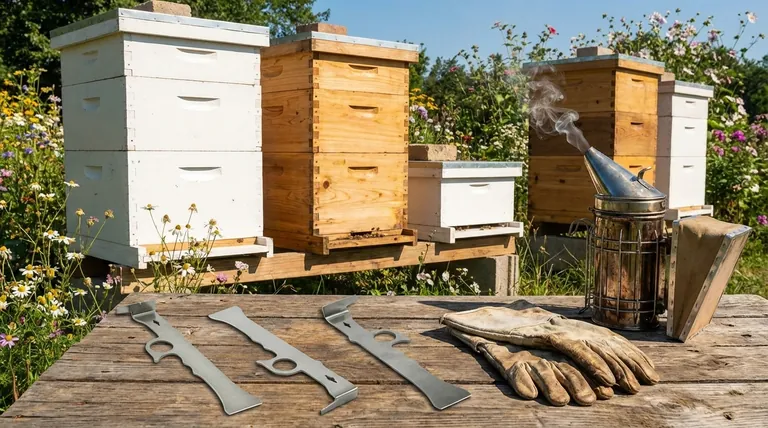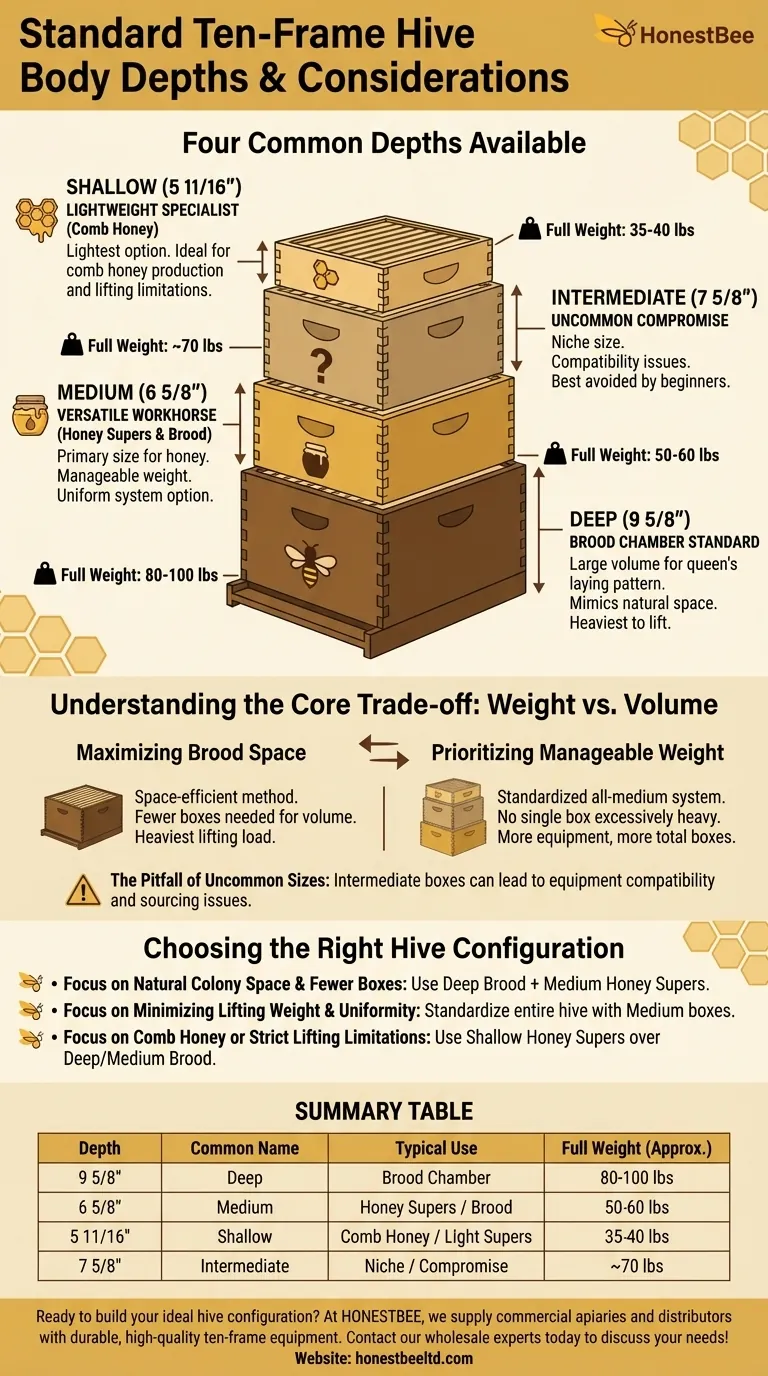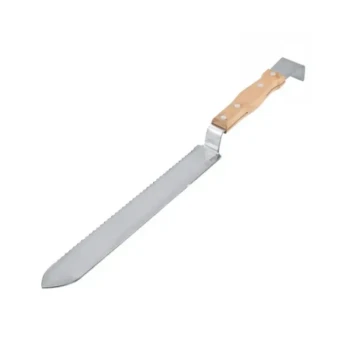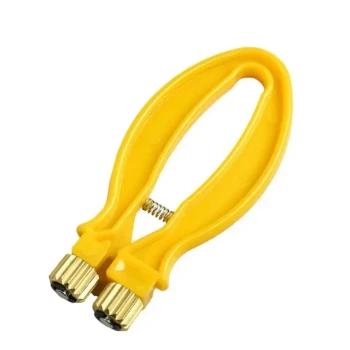When selecting a ten-frame hive body, you will find four common depths available. The standard sizes are the deep (9 5/8 inches), the medium (6 5/8 inches), the shallow (5 11/16 inches), and the less common intermediate (7 5/8 inches). Each size is designed for a specific purpose within the hive.
Choosing a hive body depth is the first critical decision in balancing the bees' needs against your own. The central trade-off is between the hive's internal volume and the weight you will have to lift.

The Role of Each Hive Body Depth
The depth of a hive box directly impacts its function, weight, and how a beekeeper manages the colony.
Deep (9 5/8") - The Brood Chamber Standard
This is the most common size used for the brood chamber, the area where the queen lays her eggs and the colony raises new bees.
Its large volume provides ample, uninterrupted space for the queen's laying pattern, closely mimicking the space inside a natural tree cavity.
However, a deep box filled with honey, pollen, and brood can weigh 80-100 pounds, making it a significant physical challenge to lift.
Medium (6 5/8") - The Versatile Workhorse
Medium boxes, often called "honey supers," are the most common size used for honey storage.
Their primary advantage is weight. A full medium super weighs a more manageable 50-60 pounds.
Many beekeepers also use medium boxes for their brood chambers. This creates a uniform, single-size system where all boxes and frames are interchangeable.
Shallow (5 11/16") - The Lightweight Specialist
Shallow boxes are the lightest option, typically weighing only 35-40 pounds when full.
They are most often used for producing comb honey, where bees build the comb directly into marketable containers. Their light weight also makes them an excellent choice for beekeepers with strict lifting limitations.
Intermediate (7 5/8") - The Uncommon Compromise
This size is not widely used and can be difficult to find.
It was designed as a compromise between the deep and medium sizes but never gained widespread popularity. Using a non-standard size can create significant equipment compatibility issues down the line.
Understanding the Core Trade-off: Weight vs. Volume
Your beekeeping philosophy and physical ability will determine which configuration is best for you.
Maximizing Brood Space
Using deep boxes for the brood chamber is the most "space-efficient" method, requiring fewer boxes to create the necessary volume for a strong colony.
This efficiency comes at the direct cost of weight. Lifting a fully-loaded deep box is the most physically demanding task in beekeeping.
Prioritizing Manageable Weight
Standardizing on all-medium boxes for both brood and honey is a popular alternative. It ensures no single box becomes excessively heavy.
The trade-off is that you will need more equipment overall (more boxes and frames) and may have to lift more total boxes during an inspection, even though each one is lighter.
The Pitfall of Uncommon Sizes
While the intermediate box exists, it is best avoided by new beekeepers. Sourcing compatible frames, foundation, and other equipment can be difficult and expensive, locking you into a niche system.
Choosing the Right Hive Configuration
Your goals dictate the best equipment choice.
- If your primary focus is mimicking natural colony space with fewer boxes: Use one or two deep boxes for the brood chamber and medium boxes for honey supers.
- If your primary focus is minimizing lifting weight and having uniform equipment: Standardize your entire hive using only medium-depth boxes for both brood and honey.
- If your primary focus is producing comb honey or you have strict lifting limitations: Use shallow boxes for your honey supers, placed above either deep or medium brood chambers.
Ultimately, selecting the right hive depth is about creating a system that works for both you and your bees.
Summary Table:
| Hive Body Depth | Common Name | Typical Use | Full Weight (Approx.) |
|---|---|---|---|
| 9 5/8 inches | Deep | Brood Chamber | 80-100 lbs |
| 6 5/8 inches | Medium | Honey Supers / Brood | 50-60 lbs |
| 5 11/16 inches | Shallow | Comb Honey / Light Supers | 35-40 lbs |
| 7 5/8 inches | Intermediate | Niche / Compromise | ~70 lbs |
Ready to build your ideal hive configuration?
At HONESTBEE, we supply commercial apiaries and beekeeping equipment distributors with the durable, high-quality ten-frame hive bodies and equipment needed for any operation. Whether you're standardizing on mediums for manageable weight or need deep boxes for maximum brood space, we provide the reliable supplies to support your success.
Contact our wholesale experts today to discuss your specific needs and get a quote!
Visual Guide

Related Products
- HONESTBEE Advanced Ergonomic Stainless Steel Hive Tool for Beekeeping
- Long Langstroth Style Horizontal Top Bar Hive for Wholesale
- 7 x Auto Bee Flow Hive Frames Plastic Beekeeping Hive Box Supplies
- Automatic Honey Flow Beehive 4 Frame Mini Hive for Beekeeping
- Multi-Functional Sliding Hive Entrance for Beekeeping
People Also Ask
- What tools are used for cleaning frames? A Beekeeper's Simple 4-Tool Guide
- What is a hive tool and what are its uses? Master Your Hive Inspections with the Essential Beekeeper's Tool
- How should beekeepers handle bees when using a hive tool? Master Calm, Deliberate Techniques
- How is a hive tool used for scraping and cleaning? Master Hive Maintenance for a Healthy Colony
- Why is it important to compare the progress of different hives? A Beekeeper's Key Diagnostic Tool



















